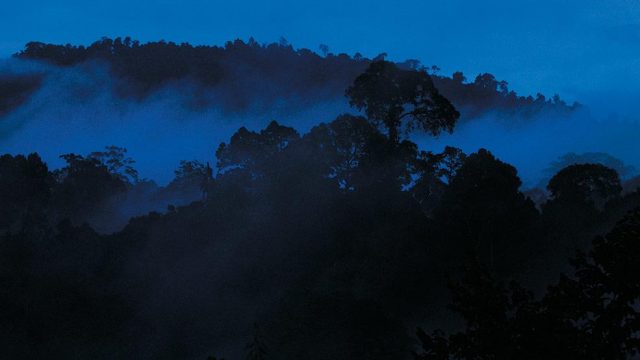The forest welcomes us into its folds, the smell of the wet earth carried by the cool breeze whipping my face. Through trees shrouded in mist, tantalisingly unknown calls and sounds emanate. Then the veil-like mist lifts briefly, and my jaw drops. The rough landing of my flight and the churning knot in the stomach are forgotten. Everything is worth this. The sun pierces through the thick, grey, evening sky to illuminate a beautiful tree here and another there, each towering over the next. And then, the veil drops once more. I step out of the car to watch the drama unfold, raindrops pelting my face.
I’m at Danum Valley in Sabah, Borneo. One of the protected and hence least-disturbed tracts of pristine, unlogged rainforests, Danum Valley is all that you ever imagined a rainforest to be. And more. For, once you actually walk through the forest, you realise how unimaginative your imagination has been. Over the next week, I allow the forest to envelop me with its sounds, smells and feel. I submit to everything vying for my attention: barely visible fungi, gigantic trees, tiny insects, impossibly hued birds, large primates and even the omnipresent leeches.
Borneo awes me with its splendour. And, as if to further drive home the point, I am shown the heavily logged forest at Sukau, along the Kinabatangan river. Even as I drive to Sukau, the contrast couldn’t be starker — the dense rainforest slowly gives way to oil palm plantations. Boating along the river, watching the exotic primates, birds or reptiles who still call this threadbare forest home, I’m reminded of the very grim reality of logging and deforestation.
Borneo still hasn’t revealed all its secrets to me; it is a lesson in patience. Though I’ve made my peace with it, I have unfinished business there: there are vertigo-inducing climate towers to be climbed, argus pheasants to be goggled at and pygmy elephants to be admired. And, of course, old friends to be met; secure in the knowledge that their home is safe.
The information
Getting there
The island of Borneo, the world’s third largest, is located north of Java. The island is divided among three countries: Indonesia, Brunei and Malaysia. Malaysian Borneo comprises the states of Sabah and Sarawak. From India, you can fly to Kota Kinabalu, capital of Sabah, via KL on Malaysia Airlines for about Rs 50,000 return. To get to Danum Valley in Sabah, where I stayed, I flew to Lahad Datu (Malaysia Airlines flies daily from Kota Kinabalu for approx. Rs 7,000 one-way). Sandakan is another airport in the region, and a good access point for Sukau, a forested area by the Kinabatangan river which I also visited (approx. Rs 5,300 one-way from Kota Kinabalu).
Where to stay
Danum Valley The Borneo Rainforest Lodge (borneorainforestlodge.com) is a comfortable, if expensive, option in Danum Valley. A 3D/2N package costs from $1,320 for a couple. They offer a variety of tour packages through their parent company, Borneo Nature Tours (borneonaturetours.com). These include excursions to and stay at the Tabin Wildlife Reserve in eastern Sabah (where you can see the Borneo pygmy elephant and the Sumatran rhinoceros).
Sukau In Sukau, there are many stay options along the Kinabatangan river, including the Sukau Rainforest Lodge (sukau.com). A 2D/1N package here starts at RM 1,269 (Rs 22,250).
Tips
Gear Carry a poncho to wear in the rain. Waterproof footwear with a good grip is essential as the forest floor is wet, uneven and slippery. Wear leech socks.
Guide It is best to visit the forest with a good, knowledgeable naturalist. Borneo has so many wonders, all of which you’ve probably never seen before. Having somebody telling you what to look at and where to look, helps.
Sukau Though the forest in Sukau has been heavily logged, do visit this area around the Kinabatangan river. It gives you a better opportunity to spot the abundant life that a rainforest houses. Sightings in a dense, un-logged forest are fewer. In Sukau, boats take you along the river, to try and spot wildlife.




